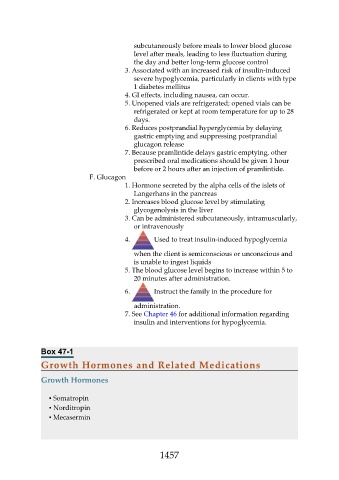Page 1457 - Saunders Comprehensive Review For NCLEX-RN
P. 1457
subcutaneously before meals to lower blood glucose
level after meals, leading to less fluctuation during
the day and better long-term glucose control
3. Associated with an increased risk of insulin-induced
severe hypoglycemia, particularly in clients with type
1 diabetes mellitus
4. GI effects, including nausea, can occur.
5. Unopened vials are refrigerated; opened vials can be
refrigerated or kept at room temperature for up to 28
days.
6. Reduces postprandial hyperglycemia by delaying
gastric emptying and suppressing postprandial
glucagon release
7. Because pramlintide delays gastric emptying, other
prescribed oral medications should be given 1 hour
before or 2 hours after an injection of pramlintide.
F. Glucagon
1. Hormone secreted by the alpha cells of the islets of
Langerhans in the pancreas
2. Increases blood glucose level by stimulating
glycogenolysis in the liver
3. Can be administered subcutaneously, intramuscularly,
or intravenously
4. Used to treat insulin-induced hypoglycemia
when the client is semiconscious or unconscious and
is unable to ingest liquids
5. The blood glucose level begins to increase within 5 to
20 minutes after administration.
6. Instruct the family in the procedure for
administration.
7. See Chapter 46 for additional information regarding
insulin and interventions for hypoglycemia.
Box 47-1
Growth Hormones and Related Medications
Growth Hormones
▪ Somatropin
▪ Norditropin
▪ Mecasermin
1457

